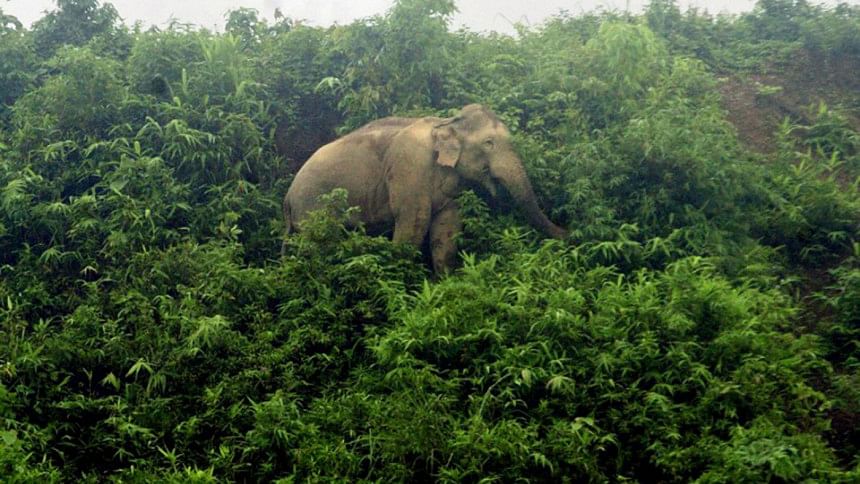Elephants face 'time bomb' in Bangladesh

Standing atop an elephant watch-tower on the outskirts of the sprawling Rohingya refugee settlement in Cox's Bazar, Nur Islam takes great pride in keeping his people safe.
Dressed in a uniform of blue T-shirt, navy trousers and a neon yellow vest, Islam is one of 570 Rohingya on the Elephant Response Team, known locally as the tusk force, who are on duty every night to look out for elephants coming into the camps.
After about 730,000 Rohingya fled Myanmar into Bangladesh 18 months ago and set up camp, they realised they were not only at risk from monsoons and cyclones but also elephants, as they were blocking a migration path, with 13 people killed in six months.
Raquibul Amin, Bangladesh representative for the International Union for Conservation of Nature (IUCN), said as a quick fix in February 2018 they built 95 towers and trained a team to watch, raise the alarm and guide elephants out of camps.
He said in the past year the all-male response team, who are paid to work, had steered elephants away from the former nature reserve on at least 50 occasions with no more fatalities.
But now 18 months into the crisis, Amin said it was becoming important to find a longer-term solution as the elephants were confined to a shrinking forest area, and needed an alternative corridor to move freely to find food or conflicts could resume.
"They are in a time bomb, a slow paced time bomb where not a very bright future is waiting for them," Amin told the Thomson Reuters Foundation from the Bangladeshi capital Dhaka.
"It should be OK for some time but they are now in a small area and will start inbreeding ... and food could be an issue."
Islam, 32, said he had been involved in stopping about 18 elephant incursions into some of the camps located from 40 km (25 miles) south of the beachside town of Cox's Bazar that now make up the world's largest refugee settlement.
ROUTE TO FREEDOM
More than 900,000 Rohingyas now live in the camps after the 2017 exodus, which followed an offensive by Myanmar's military that the United Nations has described as "ethnic cleansing".
With the influx, swathes of forest were cut down to make space and build shelters, threatening biodiversity, including the endangered Asian elephant. Its numbers have shrunk to about 50,000 globally, due largely to habitat loss, according to WWF.
The IUCN estimates there are about 268 surviving elephants in Bangladesh, of which about 15 percent, or 35-45, live around the sprawling Rohingya camp area.
Kutupalong, the largest refugee camp, was well known as a corridor for elephants moving between Myanmar and Bangladesh in winter to find food and shelter, breaking obstacles in their way which led to human conflicts.
Islam, who arrived in Cox's Bazar with his wife and two children, said he was not scared of elephants, although others were, so he stepped forward to be on the elephant team.
The project, a joint venture between IUCN and the U.N. refugee agency UNHCR, received so many applicants that they held a 100-metre running race to choose the fittest candidates.
Islam said his job was to keep watch at night and if he saw an elephant to call team members on duty in other watch-towers who would come to help drive the elephant out of the camp using megaphones and a high-powered search light.
"It's a good job because we help our people," he told the Thomson Reuters Foundation via an interpreter before climbing up the rickety, 20-feet (6 m) bamboo tower overlooking a labyrinth of mud and bamboo shelters as well as the adjacent forest.
"This will also help the elephant to survive. All this land was forest before but now it has been torn down and the elephant deserves to be conserved."
Amin said it was the response team's job to also educate the Rohingya about elephants through awareness campaigns and children's programmes.
They are also trying to encourage local Bangladeshi farmers to grow crops that elephants do not like, such as green chillies and tobacco, to stop the animals encroaching on their land in search of food and creating more human conflict.
"We need to spread the message that the elephant is not an enemy and deserves space as, like the Rohingya, it has lost access to its own land," Amin said.
He said it was unclear what impact restricting the elephants' movement would have in the longer term, or whether it would be possible to provide a new corridor.
This, he said, would involve moving about 100,000 people to new shelters, eating into the forest.
The team wants to gather more data to understand the elephants' migratory patterns, he said, and there are plans to collar and follow five of the animals in the area this year.
"It may happen that the elephants understand the loss and become more violent or desperate to move again," he said.
"Maybe we can find an alternative route for the elephants to cross ... through the camps and to the corridor."

 For all latest news, follow The Daily Star's Google News channel.
For all latest news, follow The Daily Star's Google News channel. 








Comments